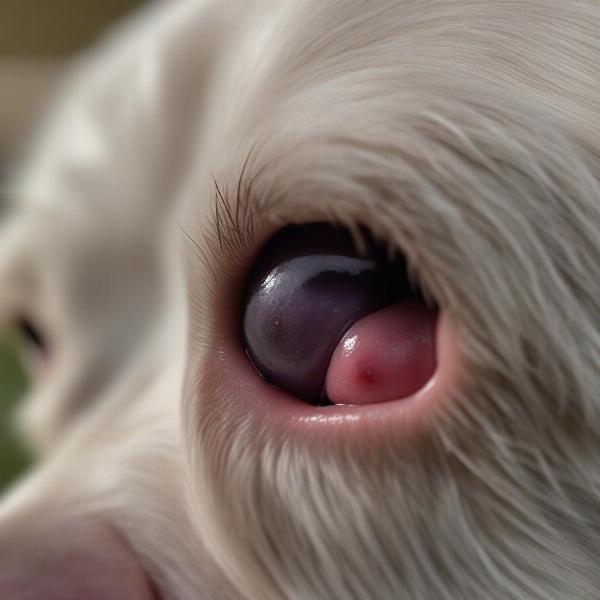Petechiae in dogs are small, pinpoint red or purple spots that appear on the skin or mucous membranes. They are caused by bleeding under the skin and can be a sign of a variety of underlying health issues. Finding these spots on your dog can be alarming, and understanding what they mean is crucial for ensuring your pet’s well-being. This guide will delve into the causes, symptoms, and treatment options related to pictures of petechiae in dogs, empowering owners with the knowledge they need to act quickly and effectively.
Understanding what petechiae looks like is the first step in addressing the issue. While a definitive diagnosis requires a vet’s expertise, being able to identify these spots can help you communicate effectively with your veterinarian and ensure your dog receives timely care. This article will provide information to help you recognize petechiae, understand potential causes, and know when to seek professional help. We’ll also discuss how to differentiate petechiae from other similar skin conditions in dogs.
Recognizing Petechiae in Your Dog
Petechiae appear as tiny, flat, round spots that range in color from bright red to dark purple. They are distinct from other skin lesions as they don’t lose color when pressed (unlike rashes which blanch). These spots can appear anywhere on your dog’s body, but they are often most noticeable on the gums, belly, or inside the ears where the skin is thinner and lighter. While they can sometimes be difficult to spot, especially on dogs with darker coats, careful examination is crucial.
 Petechiae on Dog Gums
Petechiae on Dog Gums
What Causes Petechiae in Dogs?
Petechiae can be a symptom of a wide range of conditions, from relatively minor issues to serious, life-threatening illnesses. Some of the common causes include:
- Tick-borne illnesses: Diseases like ehrlichiosis and Rocky Mountain spotted fever can disrupt blood clotting, leading to petechiae.
- Immune-mediated thrombocytopenia (ITP): This condition causes the body’s immune system to attack its own platelets, essential components for blood clotting.
- Certain medications: Some drugs can interfere with platelet function or cause bleeding disorders.
- Trauma or injury: Direct trauma to the skin can cause small blood vessels to rupture, resulting in petechiae.
- Rat poison ingestion: Rodenticides often contain anticoagulants, which prevent blood from clotting properly.
- Infections: Severe bacterial or viral infections can damage blood vessels and lead to petechiae.
When to Seek Veterinary Care
If you notice petechiae on your dog, it is essential to contact your veterinarian immediately. While not all causes are serious, early diagnosis and treatment are crucial for managing the underlying condition and preventing potential complications. Don’t delay seeking professional advice.
How will my vet diagnose the cause of petechiae?
Your vet will likely perform a thorough physical examination, review your dog’s medical history, and may recommend diagnostic tests such as blood work, urinalysis, and possibly imaging studies to determine the underlying cause of the petechiae.
Treatment Options for Petechiae
Treatment for petechiae focuses on addressing the underlying cause. This might involve medications such as antibiotics for infections, immunosuppressants for ITP, or Vitamin K for rodenticide poisoning. Supportive care, including fluid therapy and blood transfusions, may also be necessary in severe cases.
Conclusion
Discovering petechiae on your dog can be a worrying experience. However, by understanding what petechiae look like and the potential underlying causes, you can take the appropriate steps to ensure your pet receives the necessary veterinary care. Early detection and prompt treatment are key to managing the underlying condition and ensuring your dog’s well-being. Remember, always consult with your veterinarian if you have any concerns about your dog’s health.
FAQ
- Are petechiae always a sign of a serious problem? No, while petechiae can indicate serious illnesses, they can also be caused by less severe issues. It’s essential to have your vet determine the cause.
- Can petechiae go away on their own? In some cases, petechiae might resolve once the underlying cause is treated. However, they should never be ignored.
- What should I do if I find petechiae on my dog? Contact your veterinarian immediately for an appointment.
- Are certain breeds more prone to developing petechiae? Some breeds may be predisposed to certain conditions that can cause petechiae.
- Can stress cause petechiae in dogs? While stress itself doesn’t directly cause petechiae, it can exacerbate underlying conditions that might lead to their development.
- What’s the difference between petechiae and bruising? Petechiae are smaller and more numerous than bruises, which are larger areas of bleeding under the skin.
- Can flea and tick preventatives help prevent petechiae? Yes, using preventatives can reduce the risk of tick-borne illnesses, a potential cause of petechiae.
About ILM Dog
ILM Dog (https://ilmdog.com) is your trusted resource for expert advice on all aspects of dog care and well-being. We offer comprehensive information on dog breeds, health and medical care, training, nutrition, grooming, and much more. Our team of experienced writers and dog experts are dedicated to providing you with the latest information and resources to help you provide the best possible care for your canine companion. For expert advice tailored to your needs, contact us at [email protected] or call us at +44 20-3965-8624.